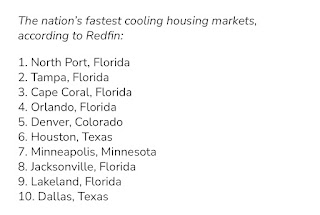Florida's Housing Markets Experience Cooling Trends

Redfin analysis reveals slowdown in Florida real estate Florida, once a red-hot destination during the pandemic, now faces cooling housing markets. Six of the nation's fastest-cooling markets are in the Sunshine State. Here's what's happening: 1. Increased Supply: Western Florida cities like North Port, Tampa, and Cape Coral have seen inventory surge by over 60% in the past year. Houses take longer to sell, prompting roughly 40% of sellers to reduce asking prices. 2. Natural Disasters Impact: Intensifying storms and rising home insurance costs discourage buyers. Coastal properties face risks due to climate change and sea-level rise. 3. New Construction: Florida is building more homes than any state except Texas. Increased supply helps moderate prices, but elevated mortgage rates challenge sellers. 4. Regional Differences: While Florida cools down, markets in the Northeast remain hot. Rochester, Buffalo (New York), and several New Jersey cities see rising prices and redu...



